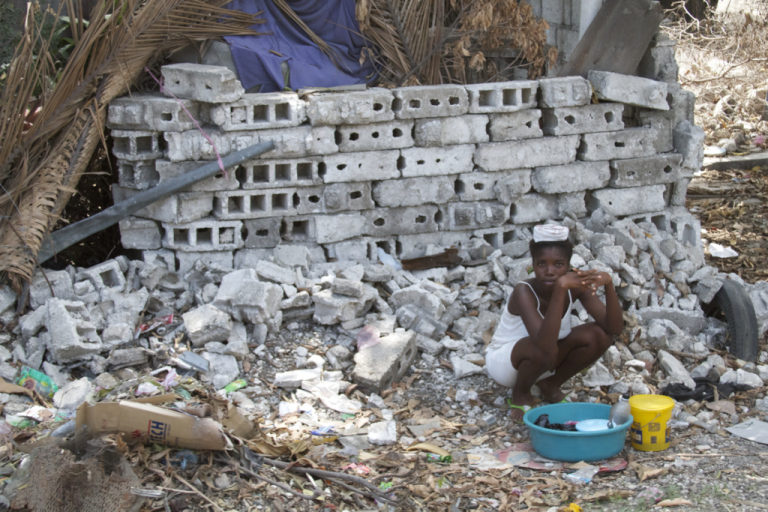
Léogâne, Haiti. It is 5pm on our first full day in Haiti. Our relief team has achieved much, but we woke up — as most Haitians do — at 5am to make it all happen. We arrived last night in Léogâne, having first flown into Port-au-Prince in the mid-afternoon.
This is my twentieth trip to Haiti over ten years. Everything seems changed — and yet nothing has changed. It is the first ever I have had to circle Port-au-Prince because air traffic was stacked up. Bill Clinton and George Bush arrived just yesterday.
As we landed, I saw more planes on the ground then I have ever seen here – and so many, many helicopters. Traditionally, there was the American Airlines flight once a day from New York and another American flight from Miami. A few Canadian flights came down from Montreal.
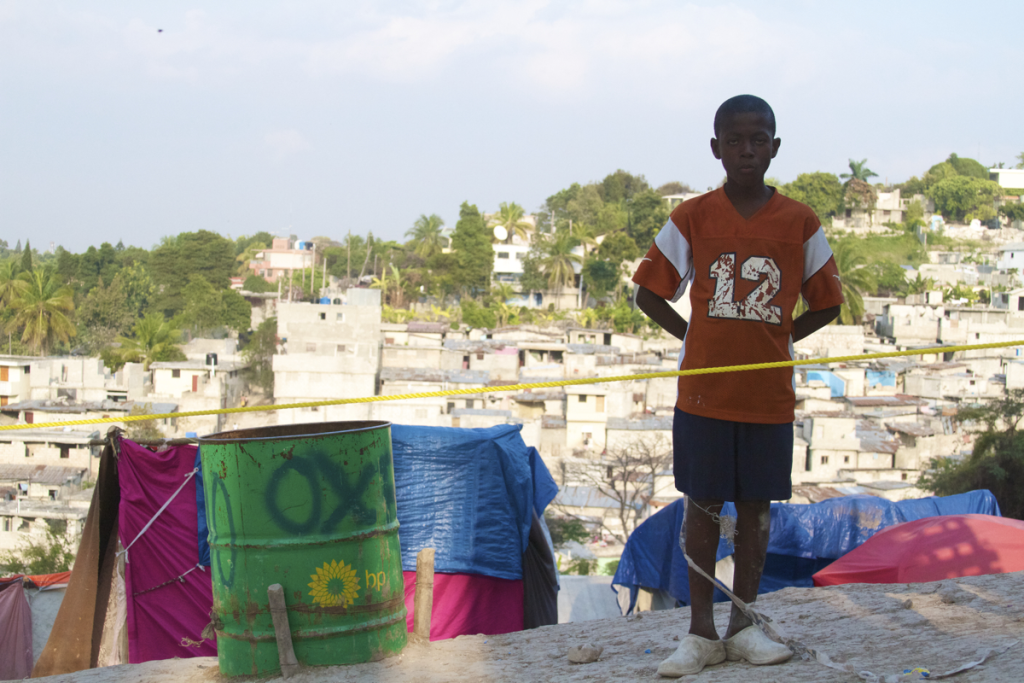
The airport terminal is surrounded by refugee tents as most of Haiti is now homeless.
The airport is unsafe and closed following the January 12 earthquake, so we were bused from the plane to a hanger where the old Immigration booths were carted over to deal with the throngs of relief workers and returning Haitians from the Diaspora.
The earthquake has severely damaged a severely damaged nation to begin with. Four out of five of Haiti’s homes are said to have collapsed, killing an untold number of people — many still buried beneath the rubble. [Update: approx. 250,000 died] There is no stench, however, due to the intensity of the unmerciful Caribbean sun.
I survived an earthquake in Aceh, Indonesia following the Tsunami there that killed about as many people. I experienced that, during a quake, one’s door shakes in its frame so violently it cannot be opened. I soon learn that most Haitians had time to leave their home, but many were so tragically imprisoned– and then violently crushed to death.
As we drove from the airport to Léogâne, 18 miles to the West, we stopped briefly to see the Presidential Palace that had collapsed. It was a frightening panorama to behold, like witnessing the White House destroyed, or as a New Yorker, perhaps visiting Ground Zero.
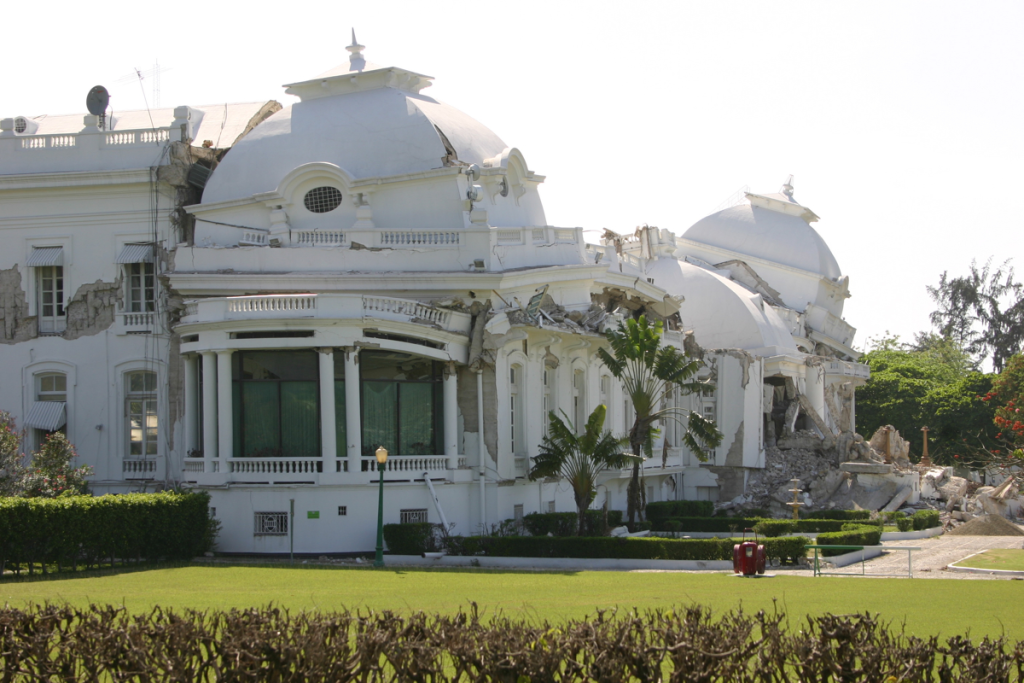
Haiti’s Presidential palace remains down, reflecting the state of the nation.
On the road to Léogâne the houses and stores are mostly down, and there are now thousands of tents – even encroaching onto the streets. I do not know the official percentage of Haitians living in tents, but I understand it is virtually the entire nation.
Even those whose homes still stand—about 10% of the country—have been warned by the government not to sleep inside because of the aftershocks. Through March, it is still officially ‘Relief & Recovery,’ but in April, theoretically, ‘Reconstruction’ begins.
On the smaller streets, much of the roads are often covered with 6-foot piles of cement debris. Cement dust coats all of Haiti, as 9/11 dust coated New York. The upcoming rains will still the dust, but the flooding and disease will be far worse.
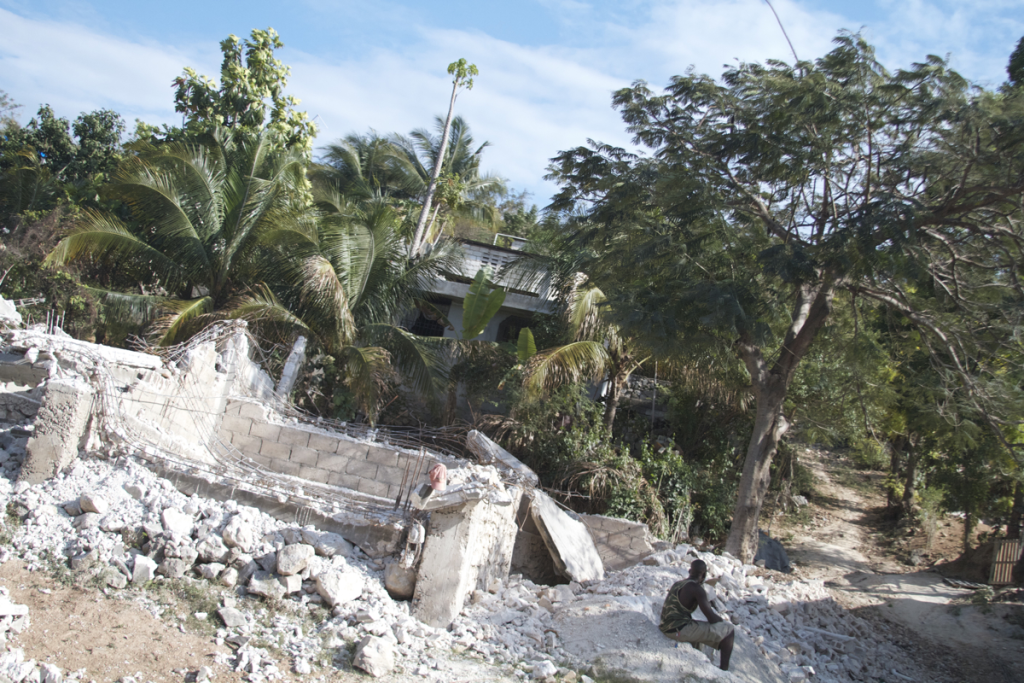
Cement debris lines the streets of Haiti, especially here in Léogâne, epicenter of destruction.
I thought I was prepared for the destruction from being in Banda Aceh, Indonesia, shortly after the Tsunami. In Sri Lanka, too. But the street scene in Haiti today reminds me more of photos I have seen of the WWII bombings of London and Berlin. Total destruction.
After the Tsunami, you could drive inland in either country until things returned to normal – usually in less than a mile. But here, there is no safety zone. Jacmel, which our team visits, seems to be the least affected.
Ironically, the streets of Haiti over the last ten years have frequently been covered in garbage, while the insides of the homes were clean. Now, the homes have all been reduced to garbage, many with dried bodies entombed inside — but an army of street sweepers keep the roadways tidy.
Today our team shared breakfast with Dr. Tiffany Keenan as she travelled from her base in Jacmel to Port-au-Prince. She was off to meet with AmeriCares and Sean Penn’s group in the nation’s capital, and half of our team joined her.
Sean’s group is known as J/P HRO (Haitian Relief Organization). The “J/P” stands for the initials of Diana Jenkins and Sean Penn. Immediately after the earthquake on January 12, Sean texted her “Haiti?” “Yes,” she responded. And their partnership was formed. They have possibly the largest population of IDP’s in the country, with more than 60,000 in one camp.
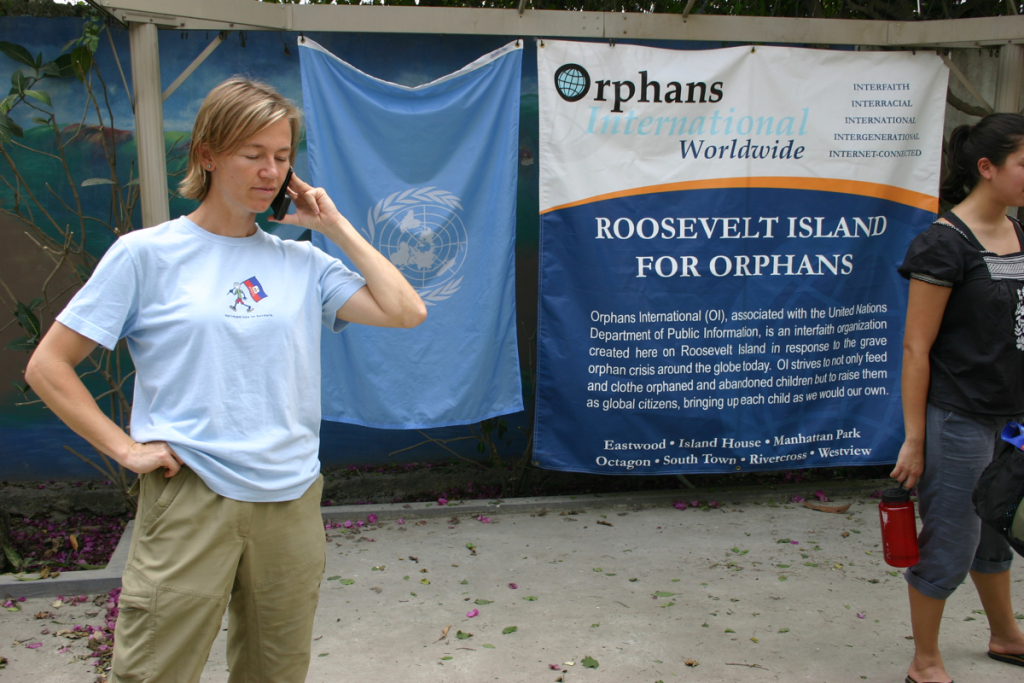
Dr. Tiffany Keenan of Bermuda knows Haiti well and has been a key player following the quake.
I know Tiffany through Paul Stevers, the visionary founder of CharityHelp International (CHI), who introduced us. She is a charismatic leader who knows all of Haiti and is dedicated to its reconstruction.
Our team reports over dinner how Sean Penn looks like he has really been living in the trenches since his arrival after the quake to organize a refugee camp. They told me two things of interest: Sean was completely adverse to publicity, and that his camp was incredibly well organized. Neither description fit my preconception of a Hollywood star.
The other half of our group stayed behind to set up our base tent, donated by a college student in Beijing, and to meet with the U.N. organizing body Office for the Coordination of Human Affairs (OCHA), the U.N. troops on the ground known as MINUSTAH, as well as UNICEF, and Save the Children. We were able to set it up with ropes and duct tape – it feels like home already.
Not as nice as the Doctors Without Borders or International Red Cross facilities we later tour, but home nonetheless to our team of about a dozen with roots in the U.S., Japan, Belgium, Korea, and China.
We are set up in the complex of Haiti’s well-known bottled water company, Belo. Yet, here, water is often bagged, not bottled. Haitians open the bag with their teeth and drink the contents in one sitting. The home of the company’s family is next to our tent – pancaked like most other homes here.
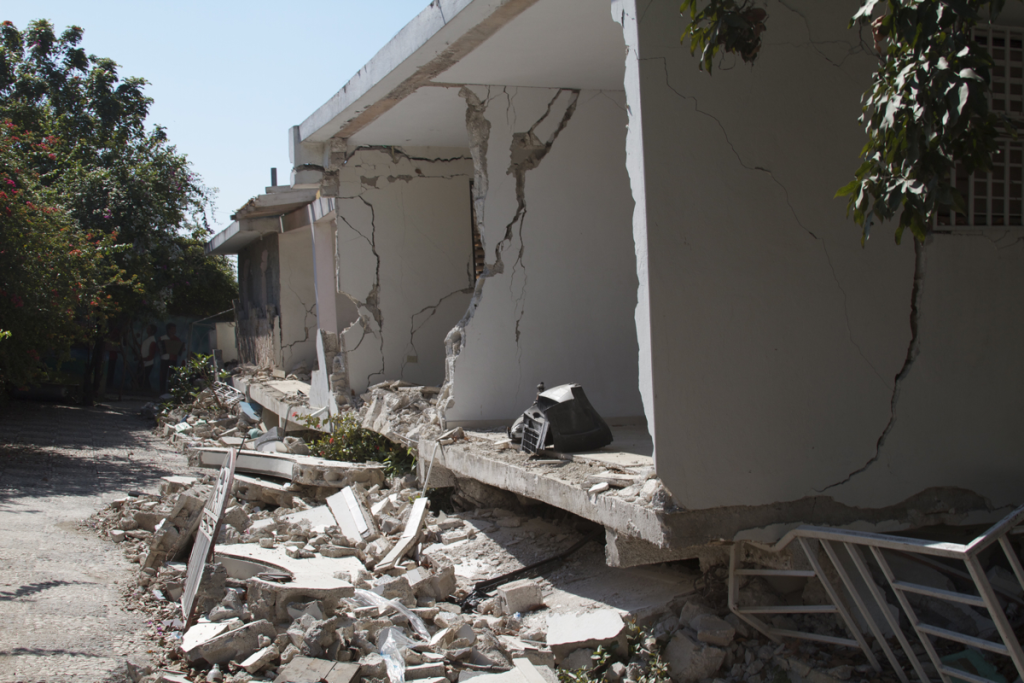
The ruins of our hosts’ home in Léogâne, the epicenter of Haiti’s earthquake.
The Belo Water Company in Léogâne survived the earthquake and gave out free water to the city for the first four weeks after the earthquake. This generous action saved the lives of hundreds, if not thousands, of survivors.
The enormity of the disaster meant that the only facility they had to offer us to stay in was the company’s main office. We were surprised by their offer to allow us to bunker down there. I could not imagine any corporation anywhere in the world welcoming relief workers into the sanctity of their president’s office.
Full electricity — running water– indoor and outdoor showers. Tent camps with IDPs in front and beside us. After erecting our own office tents, we tour two facilities that survived the quake owned by Haitian schools who we are negotiating a partnership with our team, led by Orphans International Worldwide (OIW).
Our team includes representation from my own organization, Orphans International Worldwide, Child Education International (formerly The Cambodia Project – now expanded into Sri Lanka and Haiti), the We Can’t Have That Foundation — and a slew of videographers and photographers such as Keiko Tsuyama who I wrote about last year, and Catianne Tijerina, a photojournalist from Washington, D.C.
Many Haitians are distrustful of the international NGO community and many quote to me the statistics they have read, that only 40 cents on the dollar in “Haiti aid” actually makes it to Haitians. The rest is eaten up in administrative costs. I am happy to say my own NGO has zero administrative costs as my Board pays them out-of-pocket. My own salary with Orphans International Worldwide is $1 per year.
The day would not be complete without a formal team ending. So as a special treat, off to the countryside to an outdoor restaurant where all NGOs eat. Haitian rum and Prestige – the award-winning Haitian beer – were served, and we unwound together, building community far from New York, in the warm embrace of devastated Haiti.
Photos by Morgan Freeman.
Other Stories by Jim Luce about Reconstruction in Haiti
Live Report: No Spiders to Bite Me in My Pre-Dawn Haitian Shower (Huffington Post)
Live Report: 200 Haitian Earthquake Survivors Interviewed for Ten Chinese Scholarships (Huffington Post)
Live Report: U.N. Blue Helmets from Sri Lanka Come to Our Assistance in Haiti (Daily Kos)
Live Report: Orphans International Worldwide Goes Live in Léogâne, Haiti (Daily Kos)
Live Report: Tremendous Progress Accomplished in Six Short Haitian Days (Huffington Post)
Live Report: Léogâne – Walk-Through of our New Base, Ecole la Redemption (Vimeo)
Live Report: Léogâne – Applicants for University Scholarships in Line (Vimeo)
Live Report: Léogâne – Interviewing Global Team on Back of Truck (Vimeo)
Live Report: Cement Dust Coats All of Haiti, as 9/11 Dust Coated New York. Originally published in Daily Kos, April 2, 2010.